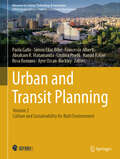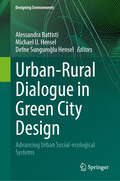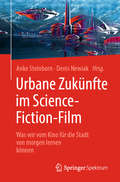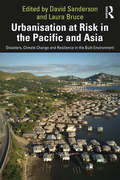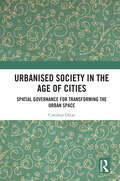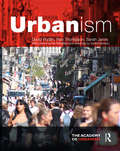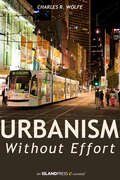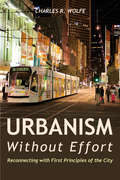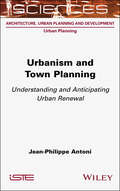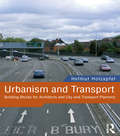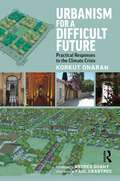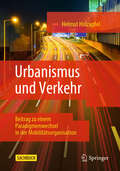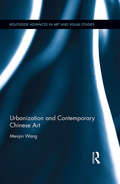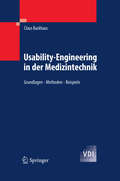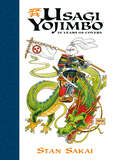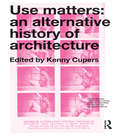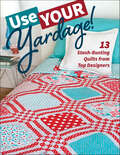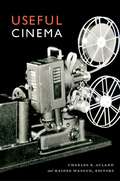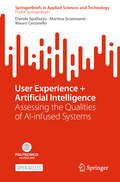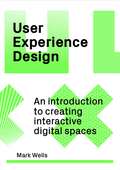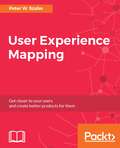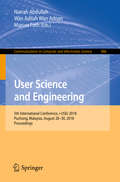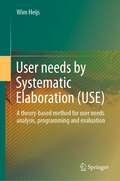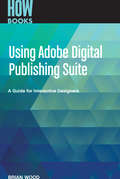- Table View
- List View
Urban and Transit Planning: Volume 2: Culture and Sustainability for Built Environment (Advances in Science, Technology & Innovation)
by Simon Elias Bibri Francesco Alberti Abraham R. Matamanda Paola Gallo Cristina Piselli Hamid Rabiei Rosa Romano Ayse Ozcan-BuckleyThis book covers a critical topic, including green building design, sustainable urban mobility, renewable energy integration, and the use of advanced technologies to minimize environmental impact. Through comprehensive analysis and practical case studies, it highlights how thoughtful design and planning can transform urban areas into resilient, eco-friendly spaces. Also, it explores the challenges and opportunities associated with implementing sustainable practices in urban planning and architectural design. It highlights successful projects from around the world, demonstrating innovative solutions that address issues. Aimed at professionals, researchers, and students, this book provides valuable insights and actionable strategies for fostering sustainable growth. It serves as an essential guide for anyone committed to creating cities and buildings that not only meet the needs of the present but also safeguard the well-being of future generations. Through its comprehensive coverage and forward-thinking approach, it inspires a new era of urban transformation focused on sustainability and resilience.
Urban-Rural Dialogue in Green City Design: Advancing Urban Social-ecological Systems (Designing Environments)
by Michael U. Hensel Alessandra Battisti Defne Sunguroğlu HenselUrbanization and construction are primary drivers of land cover and land use change, climate change and environmental degradation. Sustainable development seeks to counteract the negative impact of cities and urbanization. Shifting away from the still prevailing human-nature dialectic, social-ecological systems view humans as part of nature, thereby linking biophysical and social factors into a coherent system across spatial, temporal and functional scales. This approach and related complex and adaptive approaches and systems enable a new take on sustainable urban development and in particular green cities. The proposed book will focus on different aspects of advancing urban social-ecological systems with particular emphasis on the Urban-Rural Dialogue in Green City Design. The chapters will outline novel approaches to thinking and designing green cities, urban form as urban landform, integration of architectures and their settings, novel hybrid land use and related hybrid architectural typologies, multi-stakeholder and multi-species approaches. This will include a range of topics including green urban land use, urban ecosystem development and support, urban agriculture and food production, urban farming and gardening, and human health and well-being. Given the existing strong movement and research in this field in Italy, the book will concentrate on ground-breaking approaches and research from this region. A list of recognized authors will present approaches and discussions centering around the above-listed thematic foci concerning green cities planning, design, governance and ultimately aspects of living in green cities. The presented themes and approaches are also of more general fundamental relevance for urban contexts in other regions with comparable climate and environmental conditions. Therefore, we anticipate that the book will become a course book for many courses taught at universities worldwide, as well as a book for researchers and practitioners that wish to inform and prepare themselves for what is to come in terms of novel green city design.
Urbane Zukünfte im Science-Fiction-Film: Was wir vom Kino für die Stadt von morgen lernen können
by Ferdinando TerelleDieses Buch bietet eine außergewöhnliche Perspektive auf die nachhaltige, lebenswerte und humane Gestaltung urbaner Zukünfte, indem es sich dieser Herausforderung mit Blick auf das Science-Fiction-Kino sowie mit Bezügen zu Literatur, Architektur und Design nähert.Schon im Jahr 2050 sollen mehr als zwei Drittel aller Menschen in Ballungsräumen leben. Doch Großstädte laufen bereits heute Gefahr, an ihre Leistungsgrenzen zu stoßen: In den Megacities drohen Überbevölkerung, Verkehrschaos, Luftverschmutzung und Vereinsamung. Auf welche Weise werden solche zukünftig immer drängenderen Probleme in den fiktionalen Welten von Genreklassikern und aktuellen Blockbustern gelöst? Was lässt sich aus den fantastischen Zukunftsentwürfen zur Bewältigung urbaner Herausforderungen lernen?mediale und nachhaltige Großstadt-Architekturen New-Work-Designs und -KonzepteStrategien gegen gesellschaftliche SpaltungZu diesen und anderen Themen zeigen die Autoren eine Vielzahl von Ideen für die Stadtplanung der Zukunft auf und plädieren für das Nutzbarmachen kreativer Potenziale bei der Gestaltung lebenswerter Umgebungen.
Urbanisation at Risk in the Pacific and Asia: Disasters, Climate Change and Resilience in the Built Environment
by David Sanderson Laura BruceThis book presents practical approaches for tackling the threats from climate change and disasters to urban growth in Pacific island countries and Asian nations. With chapters written by leading scholars and practitioners, Urbanisation at Risk presents research and case studies from island countries across the Pacific, Cambodia, Nepal and the Philippines. The book explores and presents the theory, policy and practice of how governments, civil society, aid organisations and people themselves prepare for, withstand and recover better from urban disasters including windstorms, floods, earthquakes and fires, and the effects of climate change. This book is written for urban policy makers, researchers, humanitarian aid and development workers, and anyone interested in urbanisation, participatory approaches, disasters, resilience and climate change adaptation.
Urbanised Society in the Age of Cities: Spatial Governance for Transforming the Urban Space
by Cumhur OlcarThis book details the transformation processes that impinge on constitutionally ordained governance by drawing on the new theoretical approaches in the urban sciences. It is unique in terms of its focused content, which thoroughly analyses the transformation of space and governance in Turkey and beyond and how urban institutions have emerged and changed since their inception.Underlining the distinct structural characteristics, this book unearths the significant socio-political and economic processes which are critical to the political articulation of governance in cities. It follows a multidisciplinary approach which helps understand ‘the social churning’ that has radically altered the conventions of urban politics. It also attempts to draw out the theoretical implications of cities’ peculiar socio-economic and political processes, based on a rigorous empirical investigation, in which ‘political’ is envisioned and fashioned.This book will be useful to students, researchers and teachers working in the field of urban and social science, public administration, urban sociology, political economy and urban politics. It will also be an invaluable and interesting reading for those invested in Asian studies.
Urbanism
by Sarah Jarvis Rob Thompson David RudlinThe Academy of Urbanism was founded in 2006 with a mission to recognise, encourage and celebrate great places across the UK, Europe and beyond, and the people and organisations that create and sustain them. This book is a compendium of seventy five places that have been shortlisted as part of the Academy's annual awards scheme which covers great Places, Streets, Neighbourhoods, Towns and Cities. Included are 75 places shortlisted between 2009 and 2013. Each has been visited by a team of Academicians who have spent time in the place, talked to officials and local people and sought to understand what it is that makes them special and how they have achieved what they have achieved. The Academy also commissions a poem, a drawing and a figure ground plan to understand and interpret the place. David Rudlin, Rob Thompson and Sarah Jarvis have drawn on this treasure trove of material to tell the story of these 75 places. In doing so they have created the most comprehensive compendium of great urban places to have been published for many years.
Urbanism Without Effort
by Charles R. WolfeThis beautifully illustrated short e-book explores the idea that to create vibrant, sustainable urban areas for the long term, we must first understand what happens naturally when people congregate in cities--innate, unprompted interactions of urban dwellers with each other and their surrounding urban and physical environment. Wolfe elaborates on the perspective that the underlying rationales for urban policy, planning and regulation are best understood from a historical perspective and in a better understanding of the everyday uses of urban space. To make his case, Wolfe draws on his years of writing about urbanism as well as his professional experiences as a land use and environmental lawyer and offers compelling case study vignettes from everyday urban life. Successful community, Wolfe argues, is among the first principles of what makes humans feel happy, and therefore city dwellers invariably celebrate environments where and when they can coexist safely, in a mutually supportive way. Wolfe believes such celebration is most interesting when it occurs spontaneously--seemingly without effort. He contends it is critical to first isolate these spontaneous and latent examples of successful urban land use, before applying any prescriptive government policies or initiatives. Wolfe provides something rare in contemporary urbanist writing--rich illustrations and examples from real life--both historical and current. His writing about the past and the future of urban form offers readers inspiration, historical context, and a better understanding of how a sustainable, inviting urban environment is created.
Urbanism Without Effort: Reconnecting with First Principles of the City (Island Press E-ssentials Ser.)
by Charles R. WolfeHow do you create inviting and authentic urban environments where people feel at home? Countless community engagement workshops, studies by consulting firms, and downtown revitalization campaigns have attempted to answer this age-old question. In Urbanism Without Effort, Chuck Wolfe argues that "unplanned” places can often teach us more about great placemaking than planned ones. From impromptu movie nights in a Seattle alley to the adapted reuse of Diocletian's Palace in Split, Croatia, Wolfe searches for the "first principles” of what makes humans feel happy and safe amid the hustle and bustle of urban life. He highlights the common elements of cities around the world that spontaneously bring people together: being inherently walkable, factors that contribute to safety at night, the importance of intersections and corners, and more. In this age of skyrocketing metropolitan growth, he argues, looking to the past might be our best approach to creating the urban future we dream about. A whirlwind global tour, Urbanism Without Effort offers readers inspiration, historical context, and a better understanding of how an inviting urban environment is created.
Urbanism and Town Planning: Understanding and Anticipating Urban Renewal
by Jean-Philippe AntoniSustainable urban planning and urban renewal are major challenges of the 21st century. In this context, Urbanism and Town Planning proposes a geohistorical approach to urban construction. The city and its neighborhoods are studied through their materials and general layout, which sometimes reveal a logic of economic profitability, prestige and social equity, and sometimes a more innovative approach from an environmental perspective. Across these elements, unbuilt spaces (distinctive streets and squares) and built spaces (commercial and residential areas, both individual and collective) form a three-dimensional grid of “voids” and “solids”, characteristic of urban landscapes and lifestyles. Supported by numerous original examples, this book is a comprehensive summary of the most tangible elements of urban planning and development; elements that must be put into context in order to think concretely about the development of the cities of the future.
Urbanism and Transport: Building Blocks for Architects and City and Transport Planners
by Helmut HolzapfelHelmut Holzapfel’s Urbanism and Transport, a bestseller in its own country, now available in English, examines the history and the future of urban design for transport in major European cities. Urbanism and Transport shows how the automobile has come to dominate the urban landscape of cities throughout the world, providing thought-provoking analysis of the societal and ideological precursors that have given rise to these developments. It describes the transformation that occurred in urban life through the ongoing separation of social functions that began in the 1920s and has continued to produce today's phenomenon of fractured urban experience – a sort of island urbanism. Professor Holzapfel examines the vital relation between the house and the street in the urban environment and explains the importance of small-scale, mixed-use urban development for humane city living, contrasting such developments with the overpowering role that the automobile typically plays in today's cities. Taking the insights gained from its historical analysis with a special focus on Germany and the rise of fascism, the book provides recommendations for architects and engineers on how urban spaces, streets, structures and transport networks can be more successfully integrated in the present day. Urbanism and Transport is a key resource for architects, transport engineers, urban and spatial planners, and students providing essential basic knowledge about the urban situation and the challenges of reclaiming cities to serve the basic needs of people rather than the imperatives of automobile transport.
Urbanism for a Difficult Future: Practical Responses to the Climate Crisis
by Korkut OnaranUrbanism for a Difficult Future: Practical Responses to the Climate Crisis is a much-needed guide to launching the next generation of land use planning and urbanism that will enable us to adapt to and survive the consequences of climate change. The book offers strong, straightforward measures for creating a landscape of resilience via pockets of self-sufficiencies. It demonstrates how to secure systems that sustain life (energy, water, food, waste, and production of essential goods) as well as political and social protocols enabling agile decision-making in managing these systems effectively at local levels. It also provides the design principles for creating a built environment that will enable the kind of localization we need for adaptation. The book explores how it is possible to create a life that does not depend on large-scale regional sustenance systems which are likely to be disrupted or fail. This book uncovers how to enable people to be creative, productive, and supportive at local levels, so that we can achieve strong and diverse local economies that can sustain life. It will appeal to students, planners, and policy makers working in environmental studies, environmental engineering, urban and regional planning, architecture, landscape architecture, and urbanism.
Urbanismus und Verkehr: Beitrag zu einem Paradigmenwechsel in der Mobilitätsorganisation
by Helmut HolzapfelDas Sachbuch, jetzt in der dritten erneut überarbeiteten Auflage beinahe schon ein Klassiker der interdisziplinär begriffenen Verkehrs- und Stadtforschung, ist aktueller denn je. Es vermittelt auf kluge Weise Kenntnisse, der historischen und sozio-kulturellen Wurzeln einer einseitig vom Automobil dominierten Perspektive der Verkehrsplanung. Es zeigt die Entwicklung einer von fossiler Energie getriebenen Planung, die seit Jahrzehnten die sozialen und ökologischen Systeme überfordert, und vermittelt darüber hinaus Lösungsansätze, für eine menschengerechtere Stadt- und Verkehrsorganisation, die nicht ihr Heil in der Distanzüberwindung findet, sondern Qualität in der Nähe. Das völlig neu konzipierte Schlusskapitel zeigt eindringlich, dass der Wandel in Transport und Verkehr, oft als Verkehrswende bezeichnet, ohne einen radikalen Paradigmenwechsel in Verhalten, Städtebau und Mobilitätsorganisation nicht gelingen kann. Die 3. Auflage wird mit einem Vorwort von Jens Hilgenberg, Bund für Umwelt und Naturschutz Deutschland e.V. (BUND), eingeleitet.
Urbanization and Contemporary Chinese Art (Routledge Advances in Art and Visual Studies)
by Meiqin WangThis book explores the relationship between the ongoing urbanization in China and the production of contemporary Chinese art since the beginning of the twenty-first century. Wang provides a detailed analysis of artworks and methodologies of art-making from eight contemporary artists who employ a wide range of mediums, including painting, sculpture, photography, installation, video, and performance. She also sheds light on the relationship between these artists and their sociocultural origins, investigating their provocative responses to various processes and problems brought about by Chinese urbanization. With this urbanization comes a fundamental shift of the philosophical and aesthetic foundations in the practice of Chinese art: from a strong affiliation with nature and countryside to one that is complexly associated with the city and the urban world.
Usability-Engineering in der Medizintechnik
by Claus BackhausErgonomisch gestaltete Medizintechnik führt zu effizienteren Arbeitsabläufen, erhöht die Patientensicherheit und reduziert die Arbeitsbelastung. Das Buch erläutert, wie Medizintechnik an die Bedürfnisse der Nutzer und Anwender angepasst werden kann. Durch das beschriebene Vorgehen ist es möglich, sowohl die Anforderungen der harmonisierten Normen DIN EN 62366 und DIN EN 60601-1-6 umzusetzen als auch neue Lösungsansätze für die Entwicklung innovativer Medizintechnik zu erarbeiten. Die Umsetzung wird anhand ausgewählter Praxisbeispiele erörtert.
Usagi Yojimbo: 35 Years of Covers
by Stan SakaiHonoring the 35th anniversary of Stan Sakai's award-winning series Usagi Yojimbo, this deluxe art collection includes hundreds of full-page cover pieces illustrated by Stan Sakai!From clashing swords with Lord Hikiji to standing alongside the Teenage Mutant Ninja Turtles, Usagi's lively history is fully represented in this compendium of Stan's greatest covers.
Use Matters: An Alternative History of Architecture
by Kenny CupersFrom participatory architecture to interaction design, the question of how design accommodates use is driving inquiry in many creative fields. Expanding utility to embrace people’s everyday experience brings new promises for the social role of design. But this is nothing new. As the essays assembled in this collection show, interest in the elusive realm of the user was an essential part of architecture and design throughout the twentieth century. Use Matters is the first to assemble this alternative history, from the bathroom to the city, from ergonomics to cybernetics, and from Algeria to East Germany. It argues that the user is not a universal but a historically constructed category of twentieth-century modernity that continues to inform architectural practice and thinking in often unacknowledged ways.
Use Your Yardage!: 13 Stash-Busting Quilts from Top Designers
by C&T PublishingBright and modern quilts that are quick to cut and sew Use your yardage to make these 11 stash-busting quilts! The opposite of scrappy, these projects have short materials lists and big, bold designs from some of your favorite designers, including Alethea Ballard, Natalia Bonner and Kathleen Whiting, Amy Walsh, Alissa Haight Carlton, Cherri House, Amanda Murphy, Camille Roskelley, Kim Schaefer, Sweetwater, and Angela Walters. The quilts lean toward a modern aesthetic but use traditional techniques such as chain piecing and symmetry for patchwork that goes together fast! • Designs from popular quilters Alethea Ballard, Natalia Bonner and Kathleen Whiting, Amy Walsh, Alissa Haight Carlton, Cherri House, Amanda Murphy, Camille Roskelley, Kim Schaefer, Sweetwater, and Angela Walters • Huge variety of designs using both prints and solids • Graphic quilts using traditional techniques are fast and fun to make
Useful Cinema
by Haidee Wasson Charles R. AclandBy exploring the use of film in mid-twentieth-century institutions, including libraries, museums, classrooms, and professional organizations, the essays in Useful Cinema show how moving images became an ordinary feature of American life. In venues such as factories and community halls, people encountered industrial, educational, training, advertising, and other types of "useful cinema." Screening these films transformed unlikely spaces, conveyed ideas, and produced subjects in the service of public and private aims. Such functional motion pictures helped to shape common sense about cinema's place in contemporary life. Whether measured in terms of the number of films shown, the size of audiences, or the economic activity generated, the "non-theatrical sector" was a substantial and enduring parallel to the more spectacular realm of commercial film. In Useful Cinema, scholars examine organizations such as UNESCO, the YMCA, the Amateur Cinema League, and the Metropolitan Museum of Art. They also consider film exhibition sites in schools, businesses, and industries. As they expand understanding of this other American cinema, the contributors challenge preconceived notions about what cinema is. Contributors. Charles R. Acland, Joseph Clark, Zoë Druick, Ronald Walter Greene, Alison Griffiths, Stephen Groening, Jennifer Horne, Kirsten Ostherr, Eric Smoodin, Charles Tepperman, Gregory A. Waller, Haidee Wasson. Michael Zryd
User Experience + Artificial Intelligence: Assessing the Qualities of AI-infused Systems (SpringerBriefs in Applied Sciences and Technology)
by Davide Spallazzo Martina Sciannamè Mauro CeconelloThis open access book addresses the thriving trend of embedding artificial intelligence (AI) and machine learning (ML) capabilities in products and services reaching the lay public, focusing on the user experience (UX) they prompt from a designerly perspective. It offers a UX evaluation method designed explicitly for AI-infused systems to answer one of the core problems affecting the relationship and interactions people have with such artefacts. The work investigates how people perceive and make sense of systems integrating AI capabilities, trying to understand how their meaning and significance can affect the experience of such products and what design challenges may arise. Given the fundamental premise that current UX methods cannot address AI-infused artefacts, it introduces the results of Meet-AI, a research project exploring specific ways to tackle these problems. The book then presents a comprehensive analysis of current UX methods, and a literature review focused on detecting possible gaps and the most suitable qualities to describe AI-infused systems, and summarizes the findings from all previous investigations into a UX evaluation scale: AIXE (AI user eXperience Evaluation). The book also portrays how the tool has been validated and expanded to become a more comprehensive method. It further describes how the scale has been applied to a comparative study of domestic smart speakers, and introduces a reversed interpretation of the outcomes, framing them as heuristics to inform the early phases of the design process and paving the way for future experimentations in the meta-design dimension.
User Experience Design: An Introduction to Creating Interactive Digital Spaces
by Mark Wells'A great introduction to the subject and a fascinating read.'- James Friedlander-Boss, Brand Experience Manager, vvastWe all engage with digital user experience design and user interfaces every day - if you are reading this on an e-commerce platform then you are doing it right now. This is an invaluable introduction for designers and creatives on how to create successful digital environments for users.The discipline of graphic design is increasingly carried out in the virtual sphere, with a greater emphasis on user interaction and user experience than ever before. This book takes students through the crucial stages and skills that are needed for creating successful interactive digital environments, including:- Data collection- User analysis - Testing- Creating valid content- Design for different devices and platforms- Prototyping and visualizationVisual examples range from screen shots to diagrams and physical prototypes, while case studies featuring digital agencies and creatives from around the world show how they approach each project.
User Experience Design: An Introduction to Creating Interactive Digital Spaces
by Mark Wells'A great introduction to the subject and a fascinating read.'- James Friedlander-Boss, Brand Experience Manager, vvastWe all engage with digital user experience design and user interfaces every day - if you are reading this on an e-commerce platform then you are doing it right now. This is an invaluable introduction for designers and creatives on how to create successful digital environments for users.The discipline of graphic design is increasingly carried out in the virtual sphere, with a greater emphasis on user interaction and user experience than ever before. This book takes students through the crucial stages and skills that are needed for creating successful interactive digital environments, including:- Data collection- User analysis - Testing- Creating valid content- Design for different devices and platforms- Prototyping and visualizationVisual examples range from screen shots to diagrams and physical prototypes, while case studies featuring digital agencies and creatives from around the world show how they approach each project.
User Experience Mapping
by Peter W. SzaboUnderstand your users, gain strategic insights, and make your product development more efficient with user experience mapping About This Book • Detailed guidance on the major types of User Experience Maps. • Learn to gain strategic insights and improve communication with stakeholders . • Get an idea on creating wireflows, mental model maps, ecosystem maps and solution maps Who This Book Is For This book is for Product Manager, Service Managers and Designers who are keen on learning the user experience mapping techniques. What You Will Learn • Create and understand all common user experience map types. • Use lab or remote user research to create maps and understand users better. • Design behavioral change and represent it visually. • Create 4D user experience maps, the “ultimate UX deliverable”. • Capture many levels of interaction in a holistic view. • Use experience mapping in an agile team, and learn how maps help in communicating within the team and with stakeholders. • Become more user focused and help your organisation become user-centric. In Detail Do you want to create better products and innovative solutions? User Experience Maps will help you understand users, gain strategic insights and improve communication with stakeholders. Maps can also champion user-centricity within the organisation. Two advanced mapping techniques will be revealed for the first time in print, the behavioural change map and the 4D UX map. You will also explore user story maps, task models and journey maps. You will create wireflows, mental model maps, ecosystem maps and solution maps. In this book, the author will show you how to use insights from real users to create and improve your maps and your product. The book describes each major User Experience map type in detail. Starting with simple techniques based on sticky notes moving to more complex map types. In each chapter, you will solve a real-world problem with a map. The book contains detailed, beginner level tutorials on creating maps using different software products, including Adobe Illustrator, Balsamiq Mockups, Axure RP or Microsoft Word. Even if you don't have access to any of those, each map type can also be drawn with pen and paper. Beyond creating maps, the book will also showcase communication techniques and workshop ideas. Although the book is not intended to be a comprehensive guide to modern user experience or product management, its novel ideas can help you create better solutions. You will also learn about the Kaizen-UX management framework, developed by the author, now used by many agencies and in-house UX teams in Europe and beyond. Buying this map will give you hundreds of hours worth of user experience knowledge, from one of the world's leading UX consultants. It will change your users' world for the better. If you are still not convinced, we have hidden some cat drawings in it, just in case. Style and approach An easy to understand guide, filled with real world use cases on how to plan, prioritize and visualize your project on customer experience
User Science and Engineering: 5th International Conference, i-USEr 2018, Puchong, Malaysia, August 28–30, 2018, Proceedings (Communications in Computer and Information Science #886)
by Marcus Foth Natrah Abdullah Wan Adilah Wan AdnanThis book constitutes the refereed proceedings of the 5th International Conference on User Science and Engineering, i-USEr 2018, held in Puchong, Malaysia, in August 2018. The 32 papers accepted for i-USEr 2018 were selected from 72 submissions with a thorough double-blind review process. The selected papers illustrate how HCI is inclusive and omnipresent within the domains of informatics, Internet of Things, Quality of Life, and others. They are organized in the following topical sections: design, UX and usability; HCI and underserved; technology and adoption; human centered computing; HCI and IT infrastructure; and HCI and analytics.
User needs by Systematic Elaboration (USE): A theory-based method for user needs analysis, programming and evaluation
by Wim HeijsThe design of a building can facilitate the process of use and promote the well-being of users if it meets their needs. Knowledge of user needs and processes of use is important for a good design. However, it is not self-evident what user needs really are, how user needs and processes of use can be researched, and how that knowledge can be used in a design. This book introduces an integrated methodology for the analysis of user needs, programming and evaluation that answers these questions. The purpose is to improve the interaction between the users and their environment and to avoid failure costs by facilitating proper design decisions. The theoretical perspective and the conceptual framework originate from environmental psychology, more specifically P-E fit theory. The target group consists of those who are interested in creating environments for people (designers, users, real estate managers; students and scientific staff). Designers are a special audience for whom the book can be a guide to working for and with users. The theoretical perspective and the conceptual framework can also be relevant for scientific research into the interaction between users and buildings.
Using Adobe Digital Publishing Suite
by Wood BrianUsing Adobe Digital Publishing Suite is for those who want to create apps for devices like iPad using Adobe InDesign and Adobe Digital Publishing Suite. In this book, we will cover the entire creation process from designing the app in InDesign to uploading it to an app store. The tips and notes along the way will give you extra insights or faster ways to do things, as well as help you avoid typical pitfalls.
